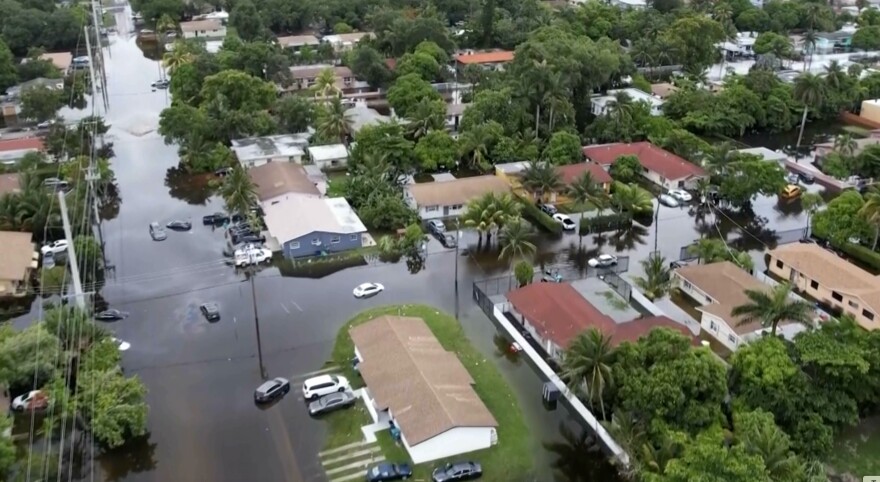This article is republished from The Conversation, an independent and nonprofit source of news, analysis and commentary from academic experts. Charles Colgan is the director of research for the Center for the Blue Economy, Middlebury Institute of International Studies.
Ocean-related tourism and recreation 320,000 jobs and US$13.5 billion in goods and services in Florida. But a swim in the ocean became much less attractive in the summer of 2023, when the water temperatures off Miami reached as high as 101 degrees Fahrenheit (37.8 Celsius).
The future of some jobs and businesses across the ocean economy have also become less secure as the ocean warms and damage from storms, sea-level rise and marine heat waves increases.
READ MORE: Florida reefs are in trouble. Could the answer lie in coral from the Caribbean?
Ocean temperatures have been over the past century, and hitting for much of the past year, driven primarily by the rise in greenhouse gas emissions from burning fossil fuels. Scientists estimate that more than produced by human activities has .
That warming, hidden for years in data of interest only to oceanographers, is now having profound consequences for coastal economies around the world.

Understanding the role of the ocean in the economy is something for more than 40 years, currently at the of the Middlebury Institute of International Studies. Mostly, I study the positive contributions of the ocean, but this has begun to change, sometimes dramatically. Climate change has made the ocean a threat to the economy in multiple ways.
The dangers of sea-level rise
One of the big threats to economies from ocean warming is sea-level rise. As . Along with meltwater from glaciers and ice sheets, thermal expansion of the water has increased and put at risk.
In the U.S., rising sea levels will soon overwhelm in Louisiana and .
Flooding at high tide, even on sunny days, is becoming increasingly common in places such as ; ; ; and San Francisco. High-tide flooding has more than doubled since 2000 and is by 2050 along the country’s coasts.

Rising sea levels also push , from which water is drawn to support agriculture. The strawberry crop in coastal California is .
These effects are still small and highly localized. Much larger effects come with storms enhanced by sea level.
Higher sea level can worsen storm damage
Warmer ocean water fuels tropical storms. It’s one reason forecasters are warning of a .
Tropical storms pick up moisture over warm water and transfer it to cooler areas. The warmer the water, the faster the storm can form, the quicker it can intensify and the , resulting in destructive storms and heavy downpours that can flood cities even far from the coasts.
READ MORE: Florida faces hectic hurricane season. Can science say who will get hit?
When these storms now come in on top of already higher sea levels, the waves and can dramatically increase coastal .
Tropical cyclones caused in the U.S. from 1980 to 2023, with an average cost of $22.8 billion per storm. Much of that cost has been absorbed by federal taxpayers.
It is not just tropical storms. Maine saw what can happen when a winter storm in January 2024 generated tides that filled coastal streets with seawater.

What does that mean for the economy?
The possible future economic damages from sea-level rise are not known because the pace and extent of rising sea levels are unknown.
One estimate puts the costs from sea-level rise and storm surge alone at over $990 billion this century, with adaptation measures able to reduce this by only . These estimates include direct property damage and damage to infrastructure such as transportation, water systems and ports. Not included are impacts on agriculture from saltwater intrusion into aquifers that support .
Marine heat waves leave fisheries in trouble
Rising ocean temperatures are also affecting marine life through extreme events, known as marine heat waves, and more gradual long-term shifts in temperature.
In spring 2024, one third of the global ocean was . Corals are struggling through their on record as warm ocean temperatures cause them to expel the algae that live in their shells and give the corals color and provide food. While corals sometimes recover from bleaching, about since 1950, and their .

Losing coral reefs is about more than their beauty. Coral reefs serve as nurseries and feeding grounds . By NOAA’s estimate, about half of all , including snapper and grouper, rely on reefs at some point in their life cycle.
Warmer waters cause fish to migrate to cooler areas. This is particularly notable with species that like cold water, such as lobsters, which have been steadily migrating north to flee warming seas. Once-robust lobstering in southern New England has .

In the Gulf of Alaska, rising temperatures almost wiped out the snow crabs, and a $270 million fishery had to be . A major heat wave extended over several years in the 2010s and disrupted fishing from Alaska to Oregon.
This won’t turn around soon
The accumulated ocean heat and greenhouse gases in the atmosphere will , even if countries cut their greenhouse gas emissions to net zero by 2050 as hoped. So, while ocean , the overall trend is likely to continue upward for at least a century.
There is no cold-water tap that we can simply turn on to quickly return ocean temperatures to “normal,” so communities will have to adapt while the entire planet works to slow greenhouse gas emissions to protect ocean economies for the future.
This article is republished from The Conversation under a Creative Commons license. Read the original article.




